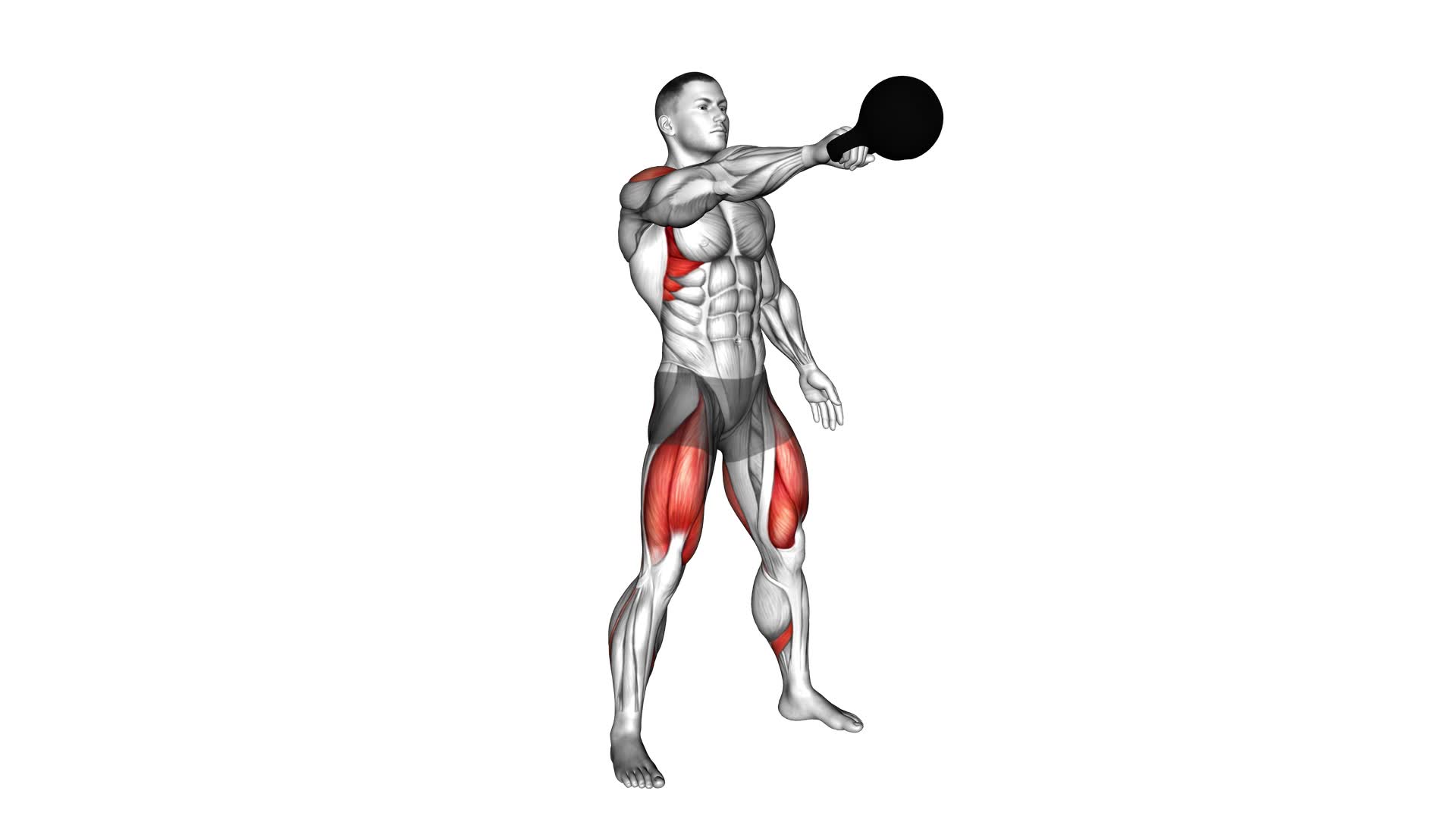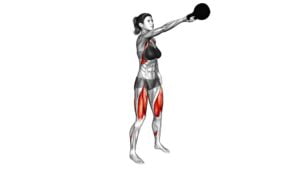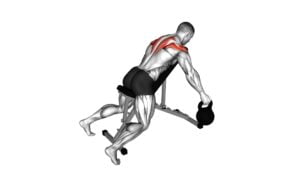Kettlebell One Arm Swing – Video Exercise Guide & Tips

Looking to add a challenging and effective exercise to your workout routine? Check out the Kettlebell One Arm Swing!
Watch This Exercise Video
This dynamic movement targets your entire body, improving strength, power, and endurance.
In this video exercise guide, we'll walk you through proper form, common mistakes to avoid, progressions, and variations.
Plus, we'll share tips to ensure a safe and effective workout.
Get ready to swing your way to a stronger, fitter you!
Key Takeaways
- The Kettlebell One Arm Swing improves cardiovascular fitness and engages large muscle groups.
- Proper form and technique involve engaging the core, hinging at the hips for power, and activating muscles for full-body engagement.
- Common mistakes to avoid include neglecting grip strength, using arms instead of hips for power, and not maintaining a strong and stable core.
- Progressions and variations of the Kettlebell One Arm Swing include the Double Kettlebell Swing, Alternating One Arm Swing, and Bottoms-Up Swing, among others.
Benefits of the Kettlebell One Arm Swing
Get stronger and improve your overall fitness by incorporating the kettlebell one arm swing into your workout routine. This exercise has numerous benefits, including improving cardiovascular fitness and building core strength.
When performing the kettlebell one arm swing, your heart rate increases significantly, leading to improved cardiovascular fitness. This exercise requires a combination of strength and endurance, as you swing the kettlebell back and forth in a controlled manner. The constant movement engages large muscle groups, such as the legs, glutes, and core, which helps to elevate your heart rate and improve your cardiovascular health.
In addition to cardiovascular benefits, the kettlebell one arm swing is also a great exercise for building core strength. As you swing the kettlebell, your core muscles are engaged to stabilize your body and maintain proper form. This exercise targets the muscles in your abs, obliques, and lower back, helping to strengthen and tone your core.
Proper Form and Technique
To perform the kettlebell one arm swing with proper form and technique, you need to focus on maintaining a strong and stable core while generating power through your hips. Here are three key elements to keep in mind:
- Engage your core: A strong core is essential for stability and proper alignment during the swing. Keep your abs tight and imagine bracing your midsection as you perform the movement.
- Hinge at the hips: The power for the swing comes from your hips, not your arms. Initiate the movement by hinging at the hips and driving them forward explosively. This hip thrust generates the momentum to swing the kettlebell.
- Activate your muscles: The kettlebell one arm swing is a full-body exercise that engages multiple muscle groups. Focus on squeezing your glutes at the top of the swing and engaging your hamstrings and core throughout the movement. This will help improve power and muscle activation.
By mastering these techniques, you can maximize the benefits of the kettlebell one arm swing, improving your power and activating key muscle groups.
Now, let's move on to discussing common mistakes to avoid and how to correct them.
Common Mistakes to Avoid
One common mistake to avoid when performing the kettlebell one arm swing isn't maintaining a strong and stable core. Your core, which includes your abdominal, back, and hip muscles, plays a crucial role in providing stability and power during this exercise. Failing to engage your core can lead to poor form and increase the risk of injury.
To ensure correct technique and injury prevention, focus on keeping your core tight and braced throughout the movement. Imagine pulling your belly button towards your spine, as if you were trying to squeeze into a tight pair of jeans. This will help you maintain a neutral spine, preventing excessive rounding or arching.
Another mistake to avoid is using your arms to lift the kettlebell instead of using your hips. The power for the swing should come from your hips and lower body, not from your arms. Engage your glutes and hamstrings to generate the force needed to swing the kettlebell, while keeping your arms relaxed and acting as a 'connector' between your body and the kettlebell.
Lastly, be mindful of your grip. Holding onto the kettlebell too tightly can lead to unnecessary tension in your forearms and shoulders. Maintain a firm, but relaxed grip, allowing the kettlebell to swing freely.
Progressions and Variations
To further challenge yourself and continue improving your kettlebell one arm swing, there are several progressions and variations you can incorporate into your routine. These advanced progressions and kettlebell swing variations will help you target different muscles and increase the intensity of your workout.
Here are three options to consider:
- Double Kettlebell Swing: Instead of using just one kettlebell, try using two. This will require more strength and coordination as you swing both kettlebells simultaneously. Make sure to maintain proper form and control throughout the movement.
- Alternating One Arm Swing: Instead of swinging the kettlebell with one arm at a time, alternate between your left and right arm for each swing. This will challenge your coordination and balance while engaging both sides of your body.
- Bottoms-Up Swing: This variation involves holding the kettlebell upside down by the handle, with the bell facing up. This forces you to engage your grip strength and stabilize the kettlebell throughout the swing, adding an extra level of difficulty.
Incorporating these advanced progressions and kettlebell swing variations into your routine will keep your workouts challenging and help you continue making progress. Remember to start with lighter weights and gradually increase the difficulty as you become more comfortable and proficient with each variation.
Tips for a Safe and Effective Workout
For a safe and effective workout, prioritize your form and technique while performing the kettlebell one arm swing.
To ensure that you're adequately prepared for your workout, start with some warm-up exercises. This will help increase blood flow to your muscles, improve flexibility, and reduce the risk of injury. Consider performing dynamic stretches such as arm circles, leg swings, and hip rotations.
Additionally, focus on your breathing techniques during the exercise. Inhale deeply through your nose as you swing the kettlebell back between your legs, and exhale forcefully through your mouth as you drive your hips forward and swing the kettlebell up to chest height. This helps engage your core and stabilize your body throughout the movement.
Remember to maintain a neutral spine, engage your glutes and core, and avoid using your lower back to generate momentum.
Frequently Asked Questions
How Heavy Should the Kettlebell Be for the One Arm Swing Exercise?
The appropriate kettlebell weight for the one arm swing exercise depends on your fitness level and experience. It's important to choose a weight that challenges you but allows you to maintain proper form.
The benefits of the one arm swing exercise include improved strength, power, and cardiovascular endurance. By incorporating this exercise into your routine, you can target multiple muscle groups and enhance your overall fitness.
Can the One Arm Swing Exercise Be Performed by Beginners?
Yes, the one arm swing exercise can be performed by beginners. It offers numerous benefits, such as improving strength, power, and cardiovascular fitness.
To make it more beginner-friendly, you can start with a lighter kettlebell and focus on proper form and technique. As you progress, you can gradually increase the weight.
Remember to listen to your body and make any necessary modifications to ensure a safe and effective workout.
Is It Necessary to Warm up Before Performing the One Arm Swing Exercise?
Before performing the one arm swing exercise, it's important to warm up. Incorporating a warm up routine before any exercise helps to increase blood flow, loosen up muscles, and reduce the risk of injury.
Additionally, proper form and technique are crucial during the one arm swing exercise to maximize its benefits and prevent strain on your back and shoulders.
How Many Sets and Repetitions Should Be Done for an Effective One Arm Swing Workout?
To have an effective one arm swing workout, it's important to consider the rep range and rest periods. For optimal muscle growth, aim for around 8-12 reps per set. This will challenge your muscles while allowing you to maintain proper form.
Rest periods between sets should be around 60-90 seconds to maximize results in your one arm swing training. Remember to listen to your body and adjust the weight and intensity as needed.
Are There Any Specific Breathing Techniques to Follow During the One Arm Swing Exercise?
To improve your form and technique during the one arm swing exercise, it's important to pay attention to your breathing techniques. Proper breathing can help you generate power and maintain stability throughout the movement.
Focus on exhaling forcefully as you swing the kettlebell up, and inhaling deeply as you lower it down. This will help engage your core and enhance your overall performance.
Practice these breathing techniques to see improvements in your form and technique.
Conclusion
In conclusion, the kettlebell one arm swing is a highly effective exercise that offers numerous benefits. By practicing proper form and technique, avoiding common mistakes, and progressing with variations, you can ensure a safe and effective workout.
Remember to follow these tips to maximize your results and prevent injury. Incorporate the kettlebell one arm swing into your fitness routine for improved strength, power, and overall fitness.

Author
Years ago, the spark of my life’s passion ignited in my mind the moment I stepped into the local gym for the first time. The inaugural bead of perspiration, the initial endeavor, the very first surge of endorphins, and a sense of pride that washed over me post-workout marked the beginning of my deep-seated interest in strength sports, fitness, and sports nutrition. This very curiosity blossomed rapidly into a profound fascination, propelling me to earn a Master’s degree in Physical Education from the Academy of Physical Education in Krakow, followed by a Sports Manager diploma from the Jagiellonian University. My journey of growth led me to gain more specialized qualifications, such as being a certified personal trainer with a focus on sports dietetics, a lifeguard, and an instructor for wellness and corrective gymnastics. Theoretical knowledge paired seamlessly with practical experience, reinforcing my belief that the transformation of individuals under my guidance was also a reflection of my personal growth. This belief holds true even today. Each day, I strive to push the boundaries and explore new realms. These realms gently elevate me to greater heights. The unique combination of passion for my field and the continuous quest for growth fuels my drive to break new ground.







